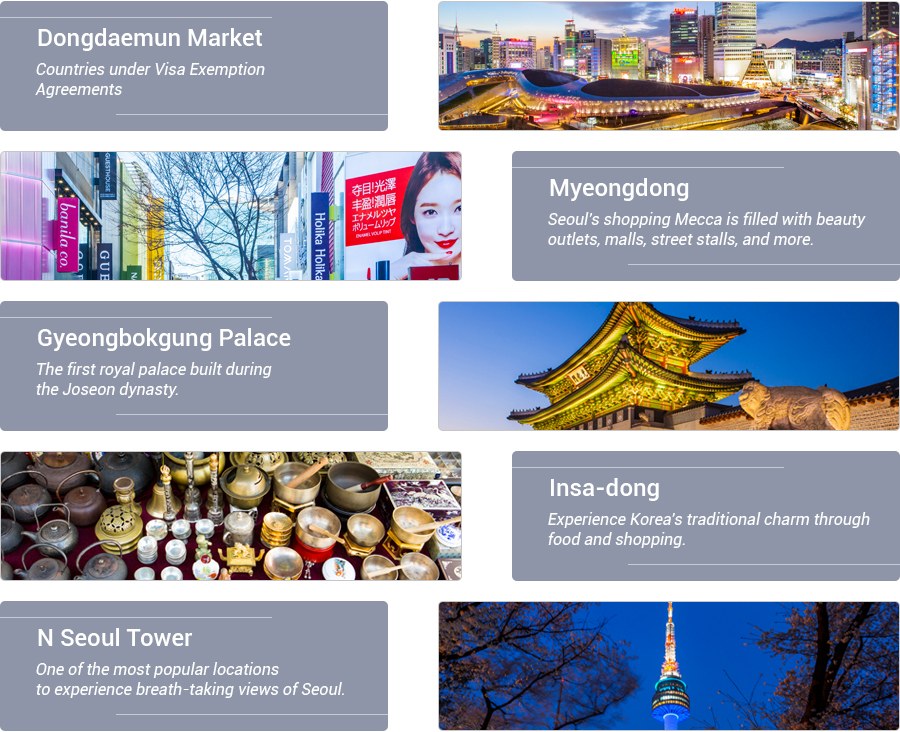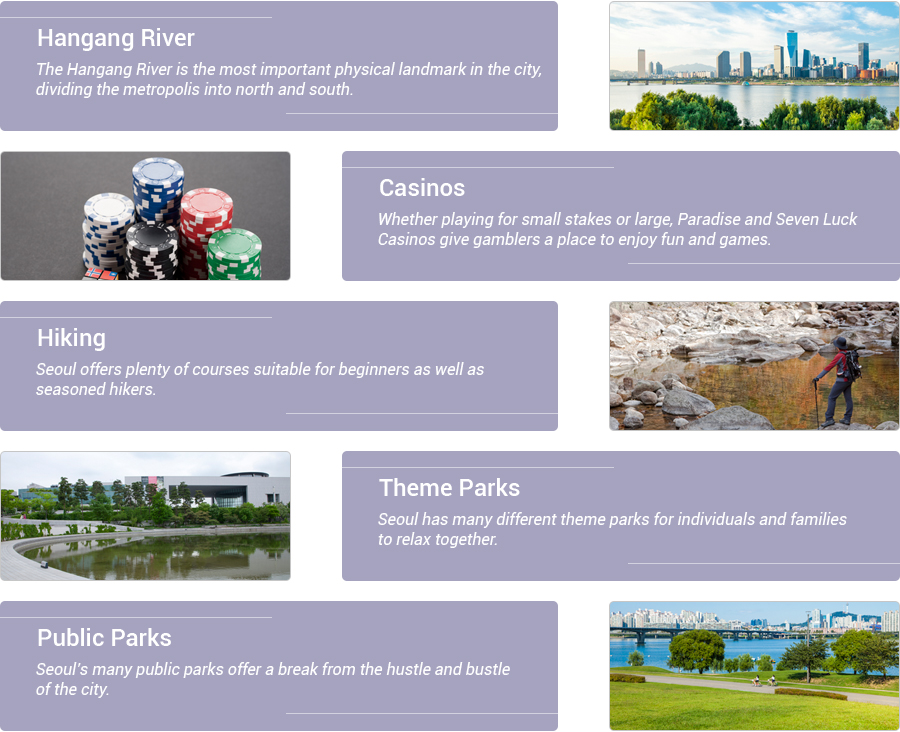
영수증 및 참가확인증은 ksccm.org 학회 홈페이지에서 확인 가능합니다.
회원은 로그인 후 마이페이지에서, 비회원은 행사 - 등록조회에서 확인 가능합니다.
View Receipt & Confirmation of participation is possible on ksccm.org homepage.
For members, allow after login - mypage, for non members can search on conference - registration.

Seoul, the capital of the Republic of Korea, is itself an important part of Korea’s cultural heritage and the most popular attraction among overseas visitors to Korea. Although it is now one of the very largest modern metropolises in the world, its downtown area is enclosed by historic walls that were originally built over 600 years ago and contains a number of valuable historical heritage including Royal Palaces, fortress gates, and old residential districts.
Located at the foot of Bugaksan, the main mountain overlooking downtown Seoul, Gyeongbokgung was the principal Royal Palace for about 200 years from its construction in 1395, just three years after the foundation of the Joseon Dynasty (1392-1910), until it was burnt down just after the commencement of the Japanese invasion of Korea in 1592. Thereafter it remained in ruins for 275 years until 1867 when it was restored; but, less than fifty years later, it fell into the hands of Japanese colonialists who destroyed the front part of the palace to build the Japanese Government-General Building on the site. The latter building, a neo-classical structure, continued to be used to house government offices even after Korea was liberated in 1945 until it was demolished in 1996 as part of an effort to remove the remaining vestiges of the colonial period. Some of the ruins of the building were moved to the Independence Hall of Korea in Cheonan, Korea for public display. Under a major renovation project to restore the palace starting in 1990, some of its buildings were restored and its main gate, Gwanghwamun, was moved to its original location. Today, the palace features some of the country’s most popular tourist attractions, including the majestic architectural pieces, Geunjeongjeon Hall and Gyeonghoeru Pavilion.
Insa-dong is a district in downtown Seoul that is packed with antique shops, antiquarian booksellers, art galleries, scroll mounters, craft workshops, brush shops, traditional teahouses, restaurants and bars that provide tourists with ample opportunities for an exciting cultural experience. The district had many places frequented by Korea artists, writers and journalists which have now begun to attract tourists from around the country and beyond. The Seoul Metropolitan Government designated Insa-dong as a District of Traditional Culture in 1988 and turns it into a car-free zone every weekend to create a more comfortable environment for visitors.
The highest and largest mountain in mainland South Korea, Jirisan Mountain consists of numerous scenic peaks, including its highest Cheonwangbong Peak (1,915m), Nogodan and Banyabong Peaks, and ridges and valleys extending for 40km from east to west. The mountain borders three provinces, Jeollanam-do, Jeollabuk-do and Gyeongsangnam-do, and its forests account for about 20% of all forestry in Korea. It was designated as Korea’s first National Park in 1967. Jirisan Mountain is located at the southern end of the Baekdu Daegan, a great mountain range that forms the backbone of the Korean Peninsula, running down from Baekdusan Mountain in the northern most part of the peninsula to characterize geographical features of the south. The mountain has been widely admired for its majestic appearance and dense forests providing natural habitats for rare animal and plant species such as the Siberian musk deer, Korean goral, Asian birch, and the Royal Azalea

Traditional markets in Korea have long been an integral part of the daily life of ordinary Korean people and are now regarded as an important element of their cultural heritage, and thus are becoming popular tourist attractions among foreign travellers in Korea. The markets, open once every five or seven days or, for some, seven days a week, not only offer a great range of commodities and farming and marine products at low prices but also present various cultural events. The attractive merits of the traditional markets include haggling over prices and getting something you want at incredibly low, "clearance" prices.

With the dokkaebi (a mythical creature in Korean folklore also known as a Korean goblin) as its mascot, the Seoul Bamdokkaebi Night Market opens in areas around Seoul and provides a unique experience. Combining a great night view, traditional market culture, specialized products and sellers and unique operating system, the Night Market became a brand name representing the nightlife of Seoul. The Bamdokkaebi Night Market opens in four areas in Seoul – Yeouido, Banpo, DDP and Cheonggyecheon.
Department stores in Korea offer a wide range of consumer goods such as clothing, food, electrical appliances, cosmetics, jewelry and housewares - usually with high-quality facilities and services. Prices tend to be higher than their competing retailers, but seasonal promotions and sales events help shoppers get high-quality products at surprisingly low prices. For foods, including fresh, cooked or half-cooked, you can buy them at much cheaper prices (50 to 70 percent of their original price) if you take advantage of closing time special offers.
Korea has several hypermarket chains enjoying brisk business with food, clothing, kitchenware and many other household items. These retailers are attracting a growing number of
Korea now has a large number of TV homeshopping channels that sell a wide range of commodities and services, clothing, foods, cosmetics, electrical appliances, and insurance, automobile and travel products. One distinctive merit of using these homeshopping channels is that you can purchase the product or service you want through a simple telephone call, and often get an opportunity to receive bonus gifts. Delivery is quick, as is the refund process
Internet shopping is still growing at an alarming speed in Korea, as in the rest of the world, due to its convenience and low prices. Some online shopping sites deal with only a small selection of products, foods, clothing or books, while others have much wider selections just like department stores. While online shopping is convenient and saves time, shoppers need to make sure that the products they see on the PC monitor are the same products they would get elsewhere, and should be aware of how their personal information is handled.

One of the most popular pork dishes in Korea, Samgyeopsal is a favored menu when dining out with family, friends, or coworkers because it is affordable and appeals to everybody’s palate. Samgyeopsal in Korea is comparable to BBQ in western countries. Some people prefer a thick chunk of pork belly prepared in the form of a steak, but generally, the pork belly is thinly sliced and grilled with chopped garlic, kimchi, or vegetables of choice. It is then served with lettuce, seasoned green onion, fresh pepper, and grilled kimchi, along with seasonings such as bean paste, hot pepper paste, salt, and sesame oil. Bibimbap: A traditional and simple dish made by mixing steamed rice with various vegetables, eggs, and red pepper paste altogether. Koreans eat Bibimbap made the traditional way on traditional holidays. It is estimated that Koreans first put Bibimbap on the table almost 500 years ago. It is easy to make and the mixture of various ingredients make it a nutritionally ideal meal.
Buchimgae and Jeon refer to many pancake-like dishes in Korean cuisine. Meats, seafoods, vegetables and eggs are mixed with flour batter and then panfried with oil. Depending on the ingredients of choice, the pancakes are called differently. Examples include pajeon made of spring onion, kimchi jeon made of kimchi and bindaetteok made of ground beans. All go well with makgeolli (Korean rice wine).
Tteokbokki, along with gimbap and odaeng (skewered fish cake), is one of the most common foods sold by street vendors. Rice powder is steamed and made into a long cylinder-shaped rice cake called garaetteok. This rice cake is cut into finger size pieces and cooked in a spicy yet sweet red pepper sauce called gochujang. Fish cakes and vegetables can be added depending on personal tastes.
Steamed rice is either simply seasoned with salt or with baehapcho, a mixed seasoning of vinegar, sugar and salt. The rice is then placed on a sheet of dried laver. Strips of eggs, eomuk (fish cake), carrot, seasoned spinach and pickled radish are then placed in the middle to be rolled together into a cylinder shape. The roll is then cut into bite-sized pieces. The taste can be quite versatile, depending on the ingredients. Gimbap is a perfect meal option for when you’re on the go!
